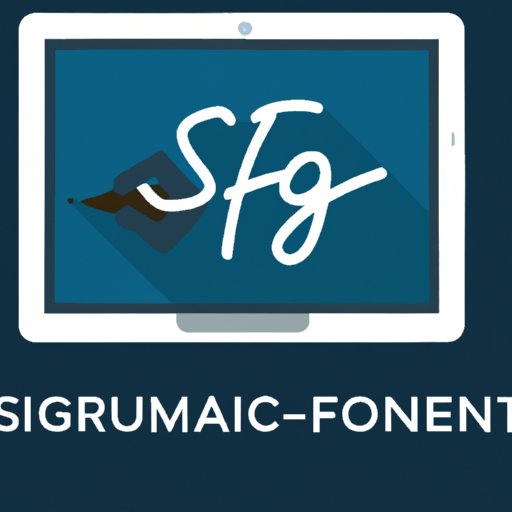
I. Introduction
E-signing, or electronic signing, has become increasingly popular for businesses and individuals alike due to its convenience, security, and efficiency. E-signatures are now legally recognized, making it a valid alternative to traditional pen-and-paper signatures.
This article provides a step-by-step guide to e-signing a PDF document, compares different online tools for e-signing, discusses accessibility tips, compliance and security measures, electronic signature laws, integrating e-signatures with workflow management software, and cloud-based signatures.
II. Step-by-Step Guide
E-signing a PDF document is a straightforward process that can be completed in as little as a few minutes. Follow the steps below:
1. Choose an E-signature Tool
There are a variety of online tools available for e-signing PDF documents. Some are free while others require a subscription. Choose the tool that best fits your needs and budget.
2. Upload Your PDF Document
Most e-signature tools allow you to upload your PDF document directly from your computer, smartphone or cloud storage service like Dropbox or Google Drive.
3. Prepare the Document for Signature
Most tools allow you to add form fields, initials, or signature boxes to the document. Position these fields on the document where signatures are required.
4. Sign the Document
Once the document has been prepared, sign it using your e-signature. Some tools may ask you to draw your signature with a mouse or use your camera to take a photo of your written signature.
5. Save and Send the Signed Document
After signing, save the document and send it to the recipient(s) via email or via the e-signature tool itself.
III. Online E-signature Tool Comparison
There are numerous online tools available for e-signing PDF documents. Here are three options with pros and cons:
1. DocuSign
Pros: Easy to use, numerous document customization options, ability to add multiple signers, option to sign documents offline.
Cons: Subscription-based, fewer features in the free version.
2. Adobe Sign
Pros: User-friendly interface, integration with Adobe Creative Cloud, secure authentication and encryption protocols.
Cons: Requires a subscription, limited customization options.
3. SignNow
Pros: Offers a free version, custom templates, mobile app available, integrations with other software programs.
Cons: Limited features in the free version, pricing higher than some competitors.
Based on the comparison, we recommend SignNow for its affordability, mobile app availability, and flexibility with other software.
IV. Accessibility Tips
It is essential to make e-signing accessible for everyone. Here are a few tips:
1. Tools and Software for the Visually Impaired
Screen reading software such as JAWS, NVDA, and VoiceOver provide users with visual impairments access to electronic documents and signatures.
2. Tools and Software for the Physically Impaired
Software such as Dragon Naturally Speaking allows physically challenged users to sign documents using voice commands.
Accessibility is crucial when it comes to electronic signing, and by keeping these tools and software in mind, the process becomes open to everyone.
V. Compliance and Security
E-signature compliance and security are critical in ensuring the validity of the signed document, and protecting sensitive information. Here are some tips:
1. Rules and Regulations
Ensure that the e-signature tool used meets legal standards and industry-specific requirements. E-signature laws and regulations vary by country and jurisdiction, so familiarize yourself with relevant laws and regulatory bodies.
2. Security Measures for Confidential Documents
The e-signature tool should provide encryption and secure digital storage to protect sensitive and confidential information. Multi-factor authentication and audit trails are additional security measures to look for in the tool.
VI. Electronic Signature Laws
Electronic signature laws vary by country and jurisdiction. It is essential to understand the legal framework surrounding electronic signatures. Here are the main points:
1. National Laws
Most countries have defined laws that regulate electronic signatures, including the United States, the European Union, Canada, Australia, and Singapore.
2. International Laws
The United Nations Commission on International Trade Law (UNCITRAL) adopted the Model Law on Electronic Signatures in 2001. The Model Law aims to harmonize electronic signature laws internationally.
3. Validity and Legality of Electronic Signatures
Electronic signatures are generally valid and enforceable if they meet national, international, and industry standards. They must also comply with contracts signed digitally.
VII. Integrating E-signatures with Workflow
Integrating e-signature tools with workflow management software or productivity software can provide numerous benefits for businesses, including:
- Increased efficiency and productivity
- Streamlined document approval process
- Reduced administrative tasks
Integrating is easy, and most e-signature tools provide application programming interfaces (APIs) that allow them to work with other software programs.
VIII. Cloud-based Signatures
Cloud-based signatures have become increasingly popular due to their convenience and accessibility. Here are some benefits of cloud-based signatures:
1. Document Tracking
Cloud-based signatures provide document tracking, so you know when the document has been received, viewed, and signed.
2. Easy Accessibility
Cloud-based signatures are accessible from any device with an internet connection, allowing for quick and easy signing from anywhere.
3. User Permissions
Cloud-based signatures provide user permissions that allow specific individuals access to the document or signature box, improving security and compliance protocols.
To use cloud-based signatures, choose an online tool that offers cloud storage, such as Dropbox or Google Drive, and an e-signature tool that integrates with your storage service.
IX. Conclusion
E-signing PDF documents has become a ubiquitous part of modern life. Whether you’re signing a document for work, school, or personal reasons, knowing how to esign a PDF is a vital skill to have.
This article provided an in-depth guide on e-signing a PDF, comparing online tools, discussing accessibility tips, compliance, electronic signature laws, integrating with workflow management software, and cloud-based signatures. By following these guidelines, you can confidently sign documents electronically with ease.
Don’t hesitate to provide feedback on this article or ask any further questions in the comments section below.




